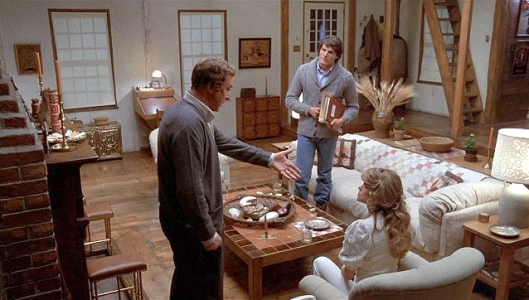Sidney Lumet’s Deathtrap may not be one of the director’s most important films, but it does show him at his skillful best. Released when I was in film school, I will always remember it being dismissed by some of my fellow students as an unabashed ripoff of Sleuth. There are certainly similarities, but then both films are based on plays which are themselves part of a well worn theatrical tradition. (The fact that Michael Caine is in both no doubt accentuates their commonalities.) It’s been years since I last saw Deathtrap, but a recent viewing confirmed that it has worn surprisingly well despite a few topical references, and that it provides some of Lumet’s liveliest and most inventive work.
Both Deathtrap and Sleuth twist and turn with the reversals and revelations central to elaborately contrived theatrical crime dramas. The major difference is that Deathtrap, adapted by Jay Presson Allen from Ira Levin’s play, has a clever Chinese-box construction. The writing of the play-within-the-play “Deathtrap” is the story of Deathtrap the film (and play), folding the elaborate games of the genre into the action itself, flaunting them brazenly, playing to the audience’s awareness of the conceits, while still delivering on the suspense and surprise. (Although the ending, perhaps inevitably, is a bit of a let down.)
Given the arch-theatricality of the situation, all of the performers (Caine, Dyan Cannon, Christopher Reeve and Irene Worth) can be forgiven for being so “on” their lines. Their frenzy and eccentricities are the mortar that holds together the tower of tricks to distract us from the absurdities, implausibilities and gaping holes in the story. It’s clear they’re having a great time playing to the gallery, and the director no doubt deserves credit for much of their success.
Lumet combined that ability to bring out the best in the actors with considerable technical sophistication. While neither skill was enough to compensate for his often coarse and obvious approach, when working with material that demanded an uncompromisingly explicit method, his literal-mindedness and lack of subtlety could produce compelling results. Deathtrap is practically a textbook demonstration of how to enliven static, constrained material with smart, apposite technique. Lumet fortunately restricts his flashier touches for moments that warrant them (his work was frequently at its worst when he gave into the temptation to show off), so that almost every shot, camera move and lighting setup contributes precisely to the lucid development of the story.
Deathtrap is, in other words, the work of people giving their all. Its greatest appeal comes from watching the skill of its unfolding, no matter how hammy and blatant. The film isn’t insightful or personal, and certainly not subtle (Johnny Mandel’s loud, brassy, pseudo-baroque score is the perfect musical equivalent of Lumet’s method). It nonetheless demonstrates that craft, smarts and commitment go a long way in the absence of deeper purpose.


Hello from Australia 🙂 , I can remember first watching DEATHTRAP when I was very young and had no idea of the plot , I have had lots of pleasant flashback memories reading your page/blog , Cheers and all the best !
Thanks, glad it worked for you. (Nothing like taking two months to reply, no?)
Pingback: The Last of Sheila | What I Watched Last Night...